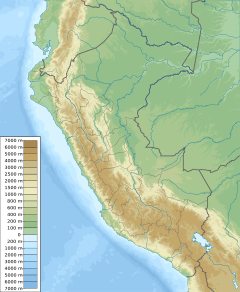Atelopus pyrodactylus facts for kids
Quick facts for kids Atelopus pyrodactylus |
|
|---|---|
| Conservation status | |
| Scientific classification | |
| Atelopus pyrodactylus is only known from the eastern slope of the Cordillera Central, Peru |
The Atelopus pyrodactylus is a special kind of toad that lives only in Peru. It belongs to the Bufonidae family, which includes many toads. This toad is very rare and has only been found in one specific area in the mountains of Peru. Its name, pyrodactylus, means "fire fingers" because its fingers and toes are a bright orange color!
Contents
What Does This Toad Look Like?
The first Atelopus pyrodactylus ever found was an adult male. Scientists call this first example the holotype. This toad was about 38 mm (1.5 in) long, measured from its nose to its rear end. It has a slender body.
Head and Face
Its head is longer than it is wide. The snout, which is its nose area, is pointed. You cannot see an eardrum, or tympanum, on this toad.
Hands and Feet
The fingers on its hands are not connected by skin, so they are unwebbed. However, its toes are partly connected by skin, meaning they are partially webbed.
Skin and Color
The toad's back, called its dorsal surface, has scattered round bumps or warts. But its shoulders, legs, hands, and feet have many more warts. The back of the toad is green with some tan, wavy lines. The top of its legs are green with yellow bumps and light orange and tan spots.
The throat, chest, and belly are orange with long black wavy lines. The underside of its legs are black with long orange patches. The palms of its hands and the soles of its feet are orange with small green spots.
Where Does This Toad Live?
The Atelopus pyrodactylus has only been found in one place. This place is called its type locality. It's a mountain ridge covered with an evergreen montane forest. This means the trees stay green all year round. This area is very high up, about 2,860 m (9,380 ft) above sea level.
The first toad found was hiding under a muddy wall next to a trail. Like other toads in the Atelopus group, this species likely has tadpoles that grow in flowing water, like streams.
Why Is This Toad in Danger?
This toad is extremely rare. Only two specimens have ever been found. One was collected in 2003, and another dead female was found in 2006. Scientists looked for more in 2008 but could not find any.
The area where this toad lives is facing many problems from humans. People are clearing the land to use it for farming. This causes the toad to lose its home. Also, a serious frog disease called chytridiomycosis is probably a big threat to this toad.
The Atelopus pyrodactylus does not live in any protected areas. However, it is legally protected by law in Peru. This means it is against the law to harm or collect these toads.



